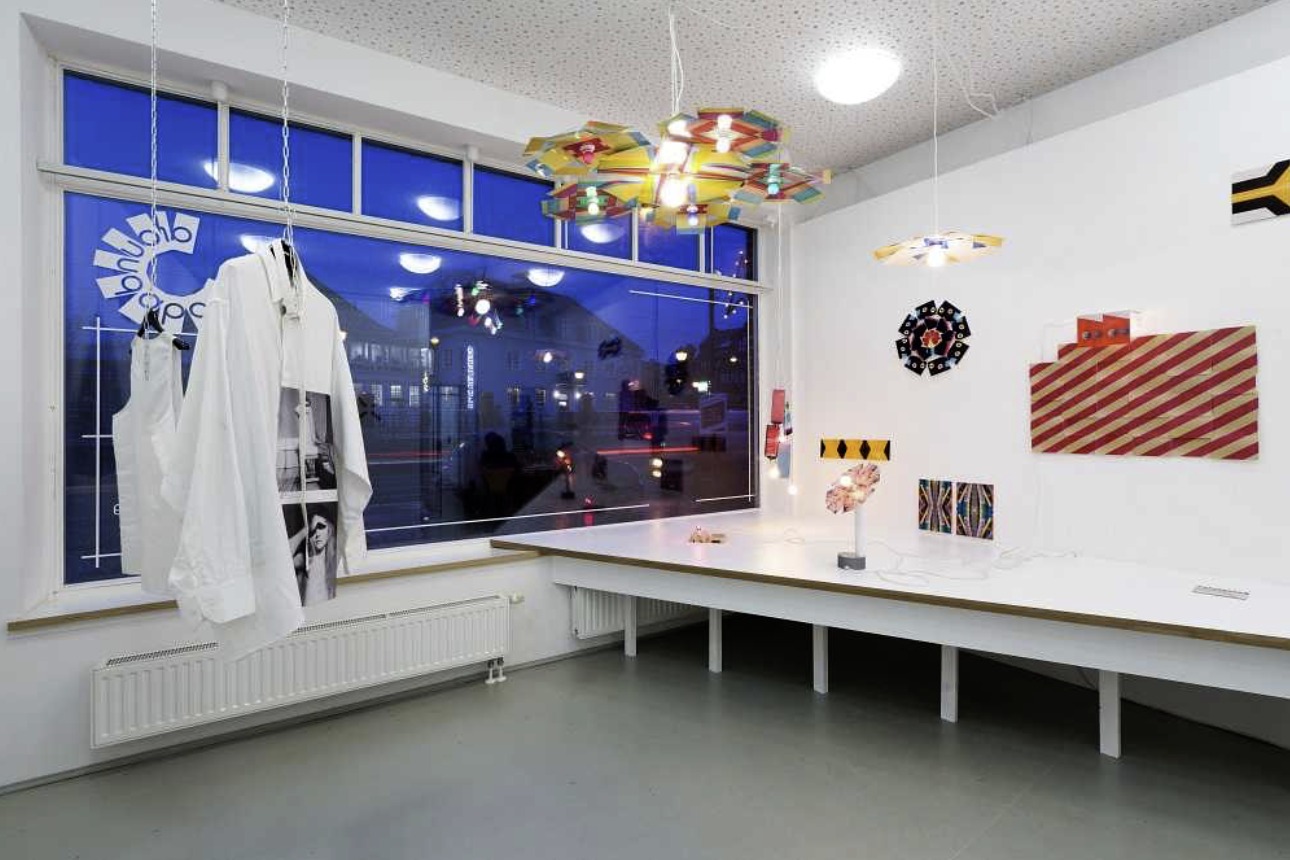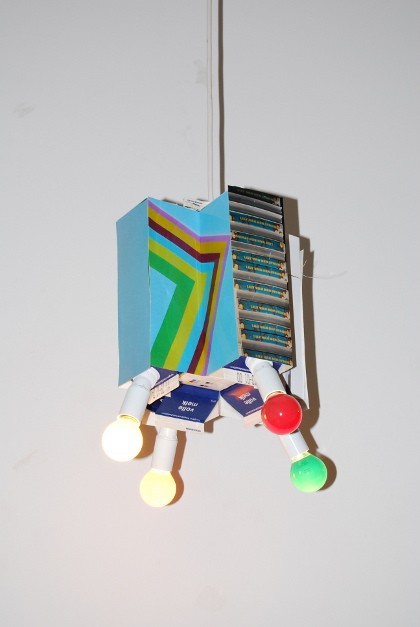Jack Jaeger
No Solo Show, No Group Show
07 Dec 2017 - 04 Feb 2018
aroundabout Jack Jaeger
Jack Jaeger (1937-2013) began making “art things”, so he wrote in one of his few statements, after having left behind a career as a film editor, cameraman, producer, and director for commercials, television, and feature films. His artistic output began around 1978, “while thinking about photography and the then current discourse with Susan Sontag and Roland Barthes.”
Jaeger’s work is a playful investigation into the nature of photography. His technique and choice of materials are disconnected from artistic virtuosity. He used ordinary, unheroic objects found in his everyday surroundings, or colored surfaces that he photographed and made into assemblages. These objects refer as much to themselves as to the ambiguity and illusion of the photographed image. He frequently treated his created photographs as objects, applying them as repetitive elements, shaping them in different relations and positions. Often, his pieces are assembled with bolts, nuts, or cables, a conscious addition of visual elements.
In addition to his activities as an artist, he worked as a curator and editor. His network of interests and contacts was broad. Together with his partner, artist Lily van der Stokker, he was an avid traveller and was present at many exhibitions and events. As a curator he was driven by a curiosity for new developments, not by a wish to theorize or to indicate trends. His pioneering and idiosyncratic exhibitions revolved around the medium of photography or focused on work by artists who didn’t restrict themselves to visual art. Despite his curatorial disregard for convention, he was well informed and often introduced works by later well-known artists such as Elke Krystufek, Wolfgang Tillmans, Jeremy Deller and Philippe Parreno. Examples include Mechanichal reproduction with artists Sylvie Fleury, Henry Bond, and Liam Gillick (Galerie van Gelder, Amsterdam, 1994); Please don’t hurt me, an exhibition around violence, including Krystufek, Van der Stokker, and Bob Flanagan (Gallery Snoei, Rotterdam and Cabinet Gallery, London, 1994); or Bring your own walkman with works and performances by artists like Martin Creed, Bob & Roberta Smith, and The Red Krayola (W139, Amsterdam, 1997). Next to his activities as an artist and curator, he brought together an extensive collection of photographs dating from the late nineteenth century until recent, which can be seen as a representation of his way of looking. During the nineties, Jaeger was also active as reporter for Zapp magazine, a seminal art magazine on VHS.
While he took his work and occupations very seriously, his objects and projects form an antidote for practices that ascribe themselves great importance. His assemblages are generous objects that seek to initiate a dialogue about moving and still images, modernism, and the work of other artists. Even though his later work, that mainly took the form of lamps, is literally illuminating and figuratively shines a light on the nature of photography, Jaeger’s modest oeuvre is also quite private. He exhibited relatively little and not many were aware of his activities as an artist. In this exhibition at Kunstverein Langenhagen, made together with Mieke van Schaijk, Jaeger’s work forms the core of the presentation, to which works of a number of equal-minded artists are added as ‘conversation partners’, among them Anne Collier, Wjm Kok, Rachel Harrison, Aloïs Godinat, Anne Daems, B. Wurtz, Steel Stillman, Michaela Meise and Wolfgang Tillmans.
Jack Jaeger (1937-2013) began making “art things”, so he wrote in one of his few statements, after having left behind a career as a film editor, cameraman, producer, and director for commercials, television, and feature films. His artistic output began around 1978, “while thinking about photography and the then current discourse with Susan Sontag and Roland Barthes.”
Jaeger’s work is a playful investigation into the nature of photography. His technique and choice of materials are disconnected from artistic virtuosity. He used ordinary, unheroic objects found in his everyday surroundings, or colored surfaces that he photographed and made into assemblages. These objects refer as much to themselves as to the ambiguity and illusion of the photographed image. He frequently treated his created photographs as objects, applying them as repetitive elements, shaping them in different relations and positions. Often, his pieces are assembled with bolts, nuts, or cables, a conscious addition of visual elements.
In addition to his activities as an artist, he worked as a curator and editor. His network of interests and contacts was broad. Together with his partner, artist Lily van der Stokker, he was an avid traveller and was present at many exhibitions and events. As a curator he was driven by a curiosity for new developments, not by a wish to theorize or to indicate trends. His pioneering and idiosyncratic exhibitions revolved around the medium of photography or focused on work by artists who didn’t restrict themselves to visual art. Despite his curatorial disregard for convention, he was well informed and often introduced works by later well-known artists such as Elke Krystufek, Wolfgang Tillmans, Jeremy Deller and Philippe Parreno. Examples include Mechanichal reproduction with artists Sylvie Fleury, Henry Bond, and Liam Gillick (Galerie van Gelder, Amsterdam, 1994); Please don’t hurt me, an exhibition around violence, including Krystufek, Van der Stokker, and Bob Flanagan (Gallery Snoei, Rotterdam and Cabinet Gallery, London, 1994); or Bring your own walkman with works and performances by artists like Martin Creed, Bob & Roberta Smith, and The Red Krayola (W139, Amsterdam, 1997). Next to his activities as an artist and curator, he brought together an extensive collection of photographs dating from the late nineteenth century until recent, which can be seen as a representation of his way of looking. During the nineties, Jaeger was also active as reporter for Zapp magazine, a seminal art magazine on VHS.
While he took his work and occupations very seriously, his objects and projects form an antidote for practices that ascribe themselves great importance. His assemblages are generous objects that seek to initiate a dialogue about moving and still images, modernism, and the work of other artists. Even though his later work, that mainly took the form of lamps, is literally illuminating and figuratively shines a light on the nature of photography, Jaeger’s modest oeuvre is also quite private. He exhibited relatively little and not many were aware of his activities as an artist. In this exhibition at Kunstverein Langenhagen, made together with Mieke van Schaijk, Jaeger’s work forms the core of the presentation, to which works of a number of equal-minded artists are added as ‘conversation partners’, among them Anne Collier, Wjm Kok, Rachel Harrison, Aloïs Godinat, Anne Daems, B. Wurtz, Steel Stillman, Michaela Meise and Wolfgang Tillmans.


